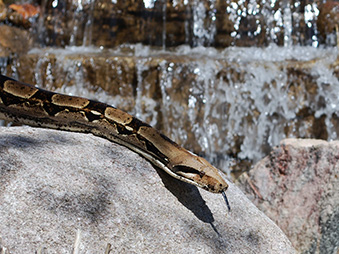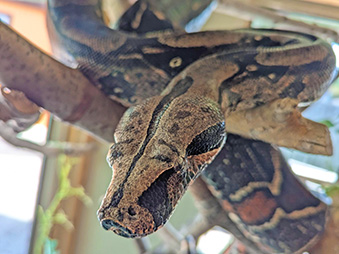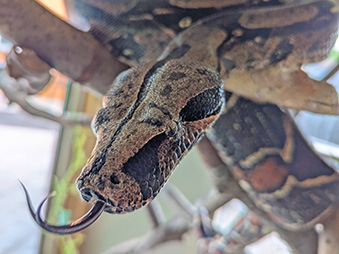Boa Constrictor ortonii | Red-tailed Boa Constrictor
Name: Scarlet (Female)



Meet Scarlet: Our Red-Tailed Boa Constrictor
Say hello to Scarlet, our graceful and powerful red-tailed boa! Native to a wide range spanning from northern Mexico through Central and South America, Scarlet belongs to a remarkable group of non-venomous snakes known as New World boa constrictors. With strength, stealth, and an amazing sense of perception, Scarlet doesn’t need venom to survive—she’s built for the art of the ambush.
Built for Ambush
Scarlet is an ambush predator, relying on her excellent camouflage to disappear into her surroundings—whether that’s forest floor leaf litter or tree branches above. She waits patiently for the perfect moment to strike. When prey gets close, she grabs it with her sharp, backward-facing teeth and coils her powerful body around it, constricting until it can no longer breathe.
Unlike venomous snakes, boa constrictors don’t inject venom. Instead, their teeth help hold onto prey while guiding it down their throat—whole! Though boas are capable swimmers, Scarlet prefers to stay on land and can sometimes be found in high branches.
Like other snakes, she uses her forked tongue, and a special organ called the Jacobson’s organ to “taste" the air. Each fork picks up scent particles from different directions, helping her track down prey and potential mates.
Life and Diet
In the wild, red-tailed boas are carnivorous generalists—they’ll eat just about anything they can catch and swallow! Mammals, birds, reptiles—you name it. Their flexible jaws and stretchy ligaments allow them to consume prey much larger than their head. Despite the myth, snakes don’t “unhinge” their jaws; instead, they have hinged bones and elastic tissues that make big meals possible.
These amazing predators also have a few more tricks to help with swallowing:
- Their body muscles contract in a rhythmic wave to help push food down the throat.
- They can still breathe while feeding thanks to a specialized breathing tube called a glottis that extends outside their mouth.
Here at the zoo, Scarlet enjoys a diet of frozen-thawed rats—just the way she likes them! And digestion takes time—it can take her 4 to 6 days to fully digest a meal. In human care, red-tailed boas like Scarlet can live 20 to 30 years, far longer than their average lifespan of 7 to 12 years in the wild.
Fascinating Features
Scarlet has plenty of amazing adaptations:
- She doesn’t have eyelids, so instead of blinking, her eyes are protected by a clear scale called a spectacle, which she sheds along with her skin.
- Unlike many reptiles, boa constrictors give birth to live young, not eggs!
- When threatened, Scarlet can let out a deep hiss loud enough to be heard from nearly 100 feet away—an impressive warning to predators!
The Importance of Snakes
Scarlet may live behind the scenes, but she plays a vital role as an ambassador animal, helping us teach guests about the biology, behavior, and importance of snakes in our ecosystems. Not only do they help control rodent populations—reducing crop damage and disease transmission—they do it naturally, without harmful chemicals.
While you’re unlikely to find a red-tailed boa constrictor in Michigan, many native snakes live here. If you spot one while hiking or in your backyard, give it space and admire it from afar. Most snakes are far more afraid of you than you are of them—and they make wonderfully helpful neighbors!
In her habitat, Scarlet enjoys textured surfaces and hiding spots for enrichment, just like she’d use in the wild. Whether she’s exploring with her flickering tongue or curled up in a quiet spot, Scarlet reminds us that snakes are essential allies.
Keeping Wild Animals Wild
Though red-tailed boas are popular in the pet trade, they’re not suitable pets for the average person. These snakes can reach lengths of up to 13 feet, and they require a very large enclosure—including both floor space and vertical climbing areas, especially when they’re young.
Proper care also includes:
- Specialized heating and lighting.
- Expert veterinary care.
- Safety measures, as even calm snakes can bite—and those bites can be painful.
- A willingness to store frozen prey animals (like rats and mice) in your home.
Sadly, many people don’t realize how much care snakes require, and boa constrictors like Scarlet often end up in rescues. In fact, Scarlet is a rescue herself. That’s why it’s best to admire these amazing reptiles in zoos, aquariums, or through educational programs. To learn more about why snakes aren’t ideal pets for most people, check out the Not-a-Pet campaign.
Fact Sheet
Taxonomy
Species: Boa constrictor ortonii
Kingdom: Animalia | Phylum: Chordata | Class: Reptilia | Order: Squamata | Family: Boidae | Genus: Boa |
Favorite Enrichment Type
Different textures (such as paper products, silicone puzzle mats, and artificial grass), cardboard box hides, brush heads.
Life Span
- In the Wild: 7 to 12 years
- In Human Care: 20 to 30 years
Diet
- In the Wild: Reptiles, mammals, birds.
- At the Zoo: Frozen thawed rats
Geographic Range
A large population distribution from norther Mexico through Central and South America.
Habitat
They prefer rainforest clearings or edges but can be found in a wide range of habitats, including grasslands, woodlands, dry tropical forests, thorn scrub, and semi-desert.
Fun Facts About Scarlet the Red-Tailed Boa!
- Hide-and-Strike Expert: Scarlet is an ambush predator, meaning she hides and waits patiently until the perfect moment to strike. Stealth mode: activated.
- No Venom Here! Boa constrictors aren’t venomous—they use their strong coils to gently (but firmly!) squeeze their prey until they can’t breathe.
- Flexible Feasting: Snakes don’t “unhinge” their jaws—they just have super stretchy ligaments that let them swallow food much bigger than their head!
- One and Done: After a big meal, Scarlet won’t eat again for up to a week. Digestion takes time!
- She Can’t Blink: Scarlet has no eyelids! Instead, her eyes are protected by a clear scale called a spectacle that she sheds along with her skin.
- Live Births Only! Unlike most reptiles, boas give birth to live babies—no eggs involved!
- Long and Strong: Red-tailed boas can grow up to 13 feet long!
- Scarlet’s Second Chance: Scarlet came to us as a rescue after being kept as a pet. Now she helps us teach others why wild animals aren’t good pets for everyone.
Status: Not Evaluated
Conservation Concerns
While red-tailed boa constrictors are not currently evaluated by the IUCN, some populations are facing serious threats. These snakes are often caught illegally for their skin, meat, or to be sold in the exotic pet trade—even though they breed easily in human care.
Habitat destruction from deforestation and agricultural expansion is shrinking their natural ranges. Even highly adaptable snakes like Scarlet can’t keep up with the rapid loss of forests and woodlands.
How to Find Me
Scarlet is a member of our Ambassador Animals that live behind the scenes! If you would like to meet Pete in person, check out our daily, 11:00am Amphitheater Presentations at the Awareness Amphitheater, located just beyond the covered bridge. Amphitheater Presentations are dependent on the weather. Please check our activity board, behind the Admissions booth, before coming to see us!
